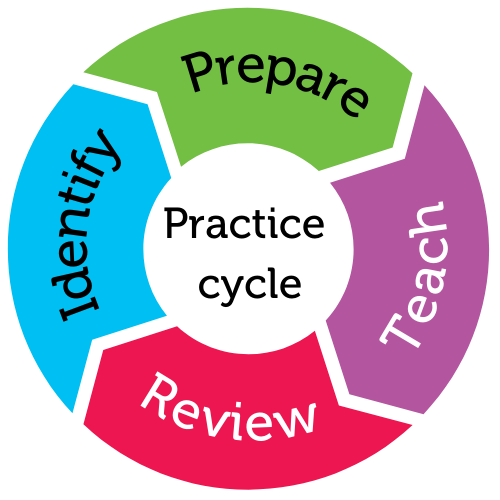
For student year
Helps students to
- increase self-esteem
- improve resilience
- increase school connectedness
Helps teachers to
- build student resilience
- create positive classrooms
- increase student responsiveness
Summary
School connectedness is a significant part of your students' emotional and social development. It's important to foster school connectedness to diminish the likelihood of school refusal (or 'school can't'). This practice uses the WISE model to help you incorporate the four major components of school connectedness into your everyday actions at school, both in the classroom and throughout the school.
The four major components of the WISE model are:
W = warmth and empathy
Use empathy, respect, and understanding to help establish warm relationships with students.
I = inclusion
Find a role and sense of belonging for students.
S = strength focus
Notice, identify, and encourage all students’ strengths.
E = equity and fairness
Support students’ differences, remove discrimination, and practice a strong sense of fairness.
How the practice works
Australian Professional Standards for Teachers related to this practice
1.1 - physical, social and intellectual development and characteristics of students
4.1 - support student participation
4.3 - manage challenging behaviour
For further information, see Australian Professional Standards for Teachers AITSL page
Preparing to teach
Why is it important?
As a teacher, you play a vital role in promoting school connectedness in your classroom and throughout the school.
Greater school connectedness means that diverse students are more likely to:
- enjoy academic success
- demonstrate prosocial behaviour through an increased sense of direction and purpose
- experience increased self-esteem
- feel optimistic
- have increased peer and teacher support
- have higher academic motivation and achievement
- intervene to prevent acts of peer-to-peer violence such as bullying
- be resilient
- experience high levels of wellbeing in subsequent years.
Importantly, students with greater school connectedness are less likely to engage in antisocial or health-risk behaviours and are less likely to experience depressive symptoms.
There are several benefits of greater school connectedness for you as a teacher, including:
- classes will be easier to manage
- more opportunities for meaningful contact with students
- students will be more responsive and warmer
- you can be yourself.
The WISE model
You can incorporate the WISE model into your everyday practice by using the following methods:
Warmth and empathy
You can help to create a warm school environment by:
- recognising the importance of relationships between all school members, including teachers, students, administration, and parents
- continually developing and working on these relationships.
Tips to create warm relationships at school:
- Use a person’s name when addressing them.
- Greet others warmly.
- Give positive feedback when appropriate.
Inclusion
Aim to create an environment where both students and teachers feel included and like they belong in the classroom, group, and school. Inclusion occurs when students feel a sense of empowerment and perceive an atmosphere of tolerance and acceptance.
Tips to foster inclusion:
- Create tasks or roles for the less-connected students.
- Create peer networks such as buddy systems.
- Promote cultural awareness and tolerance for differences.
Strength focus
You can achieve a strength focus by recognising your own strengths and those of your students and by creating tasks and an atmosphere where strengths can be promoted and cultivated.
A strength focus requires:
- recognising and believing in the abilities of yourself, students, and colleagues
- building skills and competence
- fostering your own strengths by acknowledging when you do something well.
Tips to foster your students’ strengths:
- Encourage persistence.
- Recognise achievements, no matter how small they seem.
- Challenge and encourage students to come up with their own ideas.
Equity and fairness
An equitable environment is one where there is openness and equal opportunity for all students and staff.
Tips to provide opportunities to demonstrate equity and fairness:
- Recognise and embrace differences.
- Be consistent.
- Set clear rules and boundaries.
In the classroom
Putting the WISE model into practice
Download and print the WISE model here.
Warmth and empathy
List some of the things you do, and would like to do more of:
- to promote a warm environment in your classroom
- to promote a warm environment in your school.
Inclusion
List some of the things you do, and would like to do more of:
- to create an environment where all students in your classroom feel included
- to create an environment where teachers and other school personnel feel included in your school.
Strength focus
List some of the ways you recognise:
- your own strengths
- your students’ strengths and create tasks and an atmosphere where strengths can be promoted and cultivated
- your colleagues’ strengths.
Equity and fairness
List some ways you:
- create an equitable environment in your classroom
- create an equitable environment in your school.
Helping students understand their strengths
Use the following activity to help students to understand their strengths:
- Share a story about a famous person who has succeeded despite adversity
- Brainstorm to help the students to create a list of possible strengths this person may have needed in order to overcome adversity
- Ask the students to choose someone they know or have learned about who has succeeded despite adversity, and to make a list of possible strengths this person needed in order to overcome adversity
- Ask the students to make a list of their own strengths and provide assistance to students that need it
- Encourage the students to match some of their strengths with those of their chosen person.
Weekly progress report
Create a weekly strength-focused, verbal progress report:
- At the end of each day, make a note alongside each student’s name of an effort or achievement that you noticed them doing during the day. At the end of the week, choose a noticeable effort or achievement for each student
- Share that effort or achievement for each student in a verbal progress report to the whole class in the first 15 minutes of the first class of the following week
- Display a copy of the report in the classroom for the remainder of the week, month, or term.
Practice toolkit
Practice implementation planner template
We know it's not always easy to keep track of what's working and what isn't. So, we've created this template for you to record and reflect on what you're doing to create more inclusive classrooms. The implementation planner contains:
- guidance around goal setting
- a reflection section (what worked, didn’t work, what to change, and next steps)
- prompting questions.
Implementation planner with examples
Set your professional learning goal for:
Foster school connectedness using the WISE model
Benefits of goal setting
Setting, working towards, and reflecting on goals helps you grow professionally and improve your practice. You can access AITSL learning resources for teachers to learn more about:How to set goals
The Australian Institute for Teaching and School Leadership recommends using the SMART matrix to frame your goal setting.SMART goals refers to goals that are:
- Specific
- Measurable
- Achievable
- Relevant
- Time-phased
Resources
More information can be found at www.autismteenwellbeing.com.au. The Autism Teen Wellbeing website provides resources and strategies to help build protective factors against depression and anxiety for vulnerable young people by cultivating a sense of belonging and the ability to regulate emotions in the face of stress.
Designed for parents, teachers, schools and communities to support wellbeing in teenagers on the autism spectrum, the website is the culmination of three years of collaborative research, led by the Queensland University of Technology (QUT). The research and website development were financially supported by Autism CRC and Positive Partnerships.
Foster school connectedness using the WISE model
Related Practices

Strengthen school belonging and emotional trust
TEACHING PRACTICE
For student years
Helps students to
- feel connected
- feel valued
This practice is from the core research project
Learning Cycle

